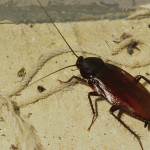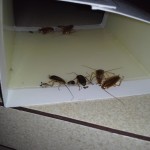Why worry about cockroach control? By Faith M. Oi, PhD, Director of Pest Management University, University of Florida
There has been much attention given to the bed bugs over the last few years. However, cockroaches remain a pest of major importance because it is a known trigger for asthma. Like the bed bugs, there is not clear experimental data indicating that cockroaches are major disease vectors, but many pathogens have been recovered from them. As always for more information on other pests or on developing an IPM program please visit our website http://schoolipm.ifas.ufl.edu/newtp4.htm
Know the Facts: Hungry bug history lesson
In 1966, Ebeling placed baited trap-jars along baseboards and in the center of a kitchen.
- Without removing competing food sources, an average of 2.4 cockroaches was caught in the traps in the jars along the baseboard, but no cockroaches were caught in the jars in the center of the room.
- When all competing food was removed, the average cockroach trap catch increased to 13.5 in jars along the baseboard and 1.2 cockroaches were trapped in jars that were placed in the center of the room.
- Hunger not only increased the number of cockroaches trapped in baited jars, but it also increased the foraging range of German cockroaches as it searched for food because competing food sources were removed.
- Take home message: remove food sources that might compete with baits and traps
Emphasis on bait Resistance Management. Are you using the same bait over and over because it seems to be working so well for you? There can be too much of a good thing. Product

American cockroach most commonly found outdoors in organic matter, but can be found lurking in kitchens, custodial closets and other damp areas.
rotation is key to staving off and possibly avoiding insecticide resistance.
According to the Insecticide Resistance Action Committee (IRAC), Insecticide resistance has defined as “a heritable change in the sensitivity of a pest population that is reflected in the repeated failure of a product to achieve the expected level of control when used according to the label recommendation for that pest species.” http://www.iraconline.org/about/resistance/
Using baits that contain active ingredients from different chemical classes on a monthly basis will help avoid cockroach populations from becoming resistant to your favorite baits. The principles of insecticide rotation were also true when the industry used primarily liquids for cockroach control.
Some researchers believe that resistance management is a misnomer and resistance is inevitable, (not futile, like the Borg ala Star Trek) but we can certainly delay its onset by proper product rotation.

Smoky brown cockroaches live primarily outdoors. They prefer warm,humid areas that don’t have a lot of air movement.
10 Best Cockroach Gel Baiting Tips from Dr. Austin M. Frishman
- When baiting cracks, do not fill the crack. Leave room for the cockroaches to sit and feast. Cockroaches like to enter tiny cracks and crevices where they’re protected.
- Avoid placement in areas over 100°F. Overly warm temperatures can cause gel baits to run, and shorten the useful life of the bait.
- Avoid placing the bait in the open in very dusty or windy areas. The material will dry out too quickly. Dried baits can harden and become less palatable or attractive to roaches.
- Suit your bait placement to the type of cockroach you intend to control. Use many small placements for German cockroaches and larger placements for American cockroaches. There might be more than one type of cockroach present at some account locations; avoid using a one-size-fits-all approach.
- Remove old, dried bait where possible. Once baits become old, hardened and dried, they’re not attractive to cockroaches. Such baits should be replaced as needed.
- Do not fill cockroach bait stations with gel. Solid baits are for the bait stations. Think of the bait tray as a tank and the gel placements as individual soldiers scattered around the protective area. Filling stations with gel might prevent cockroaches from entering to feed.
- Do not apply liquid pesticide on top of gel baits. You can only kill each cockroach once. But it’s not a good idea to contaminate your cockroach bait placements with insecticide because they might render the baits non-attractive.
- To apply in hard to reach areas, use a straight wire (from a hanger). Cover the tip with a small piece of tissue or a paper towel secured with a rubber band. Smear with the bait. Paint the hard to reach corners with the treated tip. Some bait applicator guns are available with extension applicator tips, but sometimes we need to be resourceful.
- Use a bait gun for precise application amounts. Commercially available bait guns are fine application tools that offer adjustable dispensing, which helps apply baits in an optimal fashion and avoid waste.
- After placement, take a few seconds to see whether the cockroaches respond positively and eat the bait. If not, you may have behavioral resistance and have to switch bait products. Manufacturers have conducted extensive studies on cockroach feeding preferences to provide the best cockroach bait products. However, cockroaches are masters of survival, so it’s wise to watch for any rejection of bait.
Source: PMP Magazine and The Cockroach Combat Manual II www.pest-consultant.com
School Districts Compete in EPA’s Sixth Annual Energy Star Battle of the Buildings
By: Jennah Durant or Joe Hubbard, U.S. EPA Region 6, Dallas, TX
The Environmental Protection Agency (EPA) launched the 2015 Energy Star Battle of the Buildings. In Texas, the Carrollton-Farmers Branch, Mansfield, Houston, and Frisco Independent School Districts are among 125 teams and 6,500 buildings nationwide competing head-to-head to reduce their energy and water use. In support of President Obama’s Climate Action Plan, which calls for businesses to cut waste and become at least 20 percent more energy efficient by 2020, the competition specifically targets wasted energy in commercial buildings and motivates organizations to improve energy efficiency, reduce harmful carbon pollution, and save money.
“We fully expect our competitors in this year’s challenge to lead the way for other companies to follow,” said EPA Regional Administrator Ron Curry. “Our schools and businesses have proven, time after time, their ability to reduce energy and water use by relying on both practical best practices and creating new innovative tools.”
“Congratulations to all of the competitors in this year’s Battle of the Buildings, from police and fire stations to some of our biggest office buildings, and just about every type of building in between,” said EPA Administrator Gina McCarthy. “Year after year, you show us the power of competition to unlock energy and water savings and protect the environment. In this race, everyone wins.”
In the only coast-to-coast competition of its kind, dozens of different types of commercial buildings face off in each year’s Battle of the Buildings. The Team Challenge features groups of five or more buildings that will work together to reduce their collective energy use over the course of a year. For example, Target, TD Bank and Union Bank have all signed up teams for this year’s competition.
Last year’s winner, the small town of Woodville, Alabama, has also returned for another round of savings. Other teams include Des Moines, Iowa’s 37 elementary schools, competing against the county’s middle and high schools. The City of Los Angeles’ animal shelters are competing against the City’s libraries, offices and facilities from the general services and sanitation departments.
And this year’s competition offers some exciting individual building contests, with both the William Jefferson Clinton and the George Bush Presidential Libraries competing, and Citi Field, home of the New York Mets, hoping to score more savings than Ford Field, home of the Detroit Lions.
Competitors measure and track their energy and water consumption online using EPA’s Energy Star Portfolio Manager tool. Over the course of the competition, participants work to optimize or upgrade equipment, retrofit lighting, and change occupants’ behaviors— all with help from Energy Star. The team and individual buildings that reduce energy use the most on a percentage basis over a 12-month performance period will be declared winners. More than 1,000 buildings are also competing in a special water reduction category and will work with EPA’s WaterSense program to apply best practices for commercial building water management. Midpoint results will be posted in early October, and the winners will be announced in May 2016.
This is the sixth year EPA is hosting the Battle of the Buildings, and the competition and positive environmental impacts keep growing. Last year’s competitors saved a combined total of more than two billion kBtus of energy and an estimated $50 million on utility bills. More than 60 buildings in the competition demonstrated energy use reductions of 20 percent or greater over the course of the year.
Commercial buildings in the United States are responsible for 17 percent of the nation’s energy use and greenhouse gas emissions at a cost of more than $175 billion annually. By improving the energy efficiency of the places Americans work, play, and learn, the competitors help save energy and reduce harmful greenhouse gas emissions that contribute to climate change.
Energy Star is the simple choice for energy efficiency. For more than 20 years, people across America have looked to EPA’s ENERGY STAR program for guidance on saving energy, saving money, and protecting the environment. Behind each blue label is a product, building, or home that is independently certified to use less energy and cause fewer of the emissions that contribute to climate change. Join the millions already making a difference at energystar.gov.
More information on the competition: http://www.energystar.gov/BattleOfTheBuildings
EPA’s August 4, 2015 Webinar features Information on How School Districts are Saving Money, Increasing Energy Efficiency and Protecting Health
Improved occupant health, cost savings, energy efficiency webinar, the NPSD Director of Facilities and Operations will share how he achieved health and energy savings goals using the U.S. Environmental Protection Agency’s (EPA) Energy Savings Plus Health: Indoor Air Quality Guidelines for School Building Upgrades (the Guide) and Energy Savings Plus Health Checklist Generator.
Webinar Highlights
• Hear how a Director of Facilities and Operations uses the Guide to protect student and staff health during building maintenance and retrofit projects.
• Find out how to take a proactive approach to saving energy and money, including what procedures, policies, best practices and key principles facility managers need to understand to effectively protect IAQ while increasing energy efficiency.
• Learn how to use the Energy Savings Plus Health Checklist Generator to create customized verification checklists.
Featured IAQ and Energy Efficiency Experts
• Kudret Ütebay, The Cadmus Group, Inc., Deputy Program Manager for EPA’s ENERGY STAR® Commercial, Institutional and Industrial Sectors
• Tom Schneider, Director of Facilities and Operations, North Penn School District, Pennsylvania
• Michele Curreri, Environmental Protection Specialist, U.S. EPA Indoor Environments Division
Don’t miss out!
Register today at: education.cefpi.org/index.cfm?pg=semwebCatalog&panel=showLive&seminarid=6235



 .
.